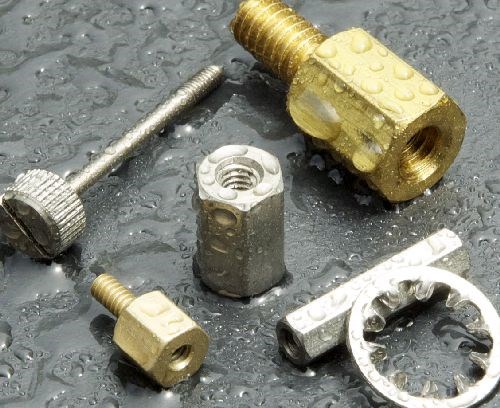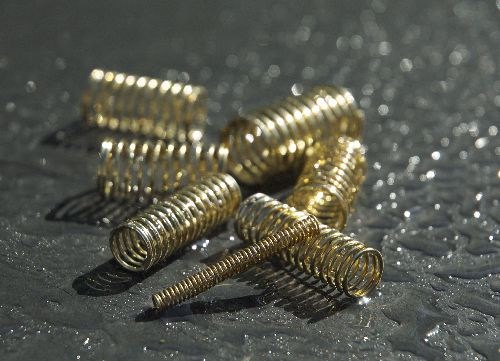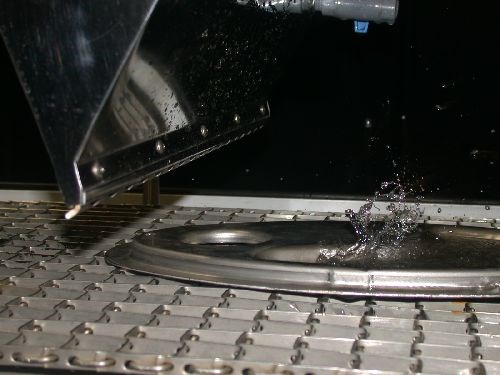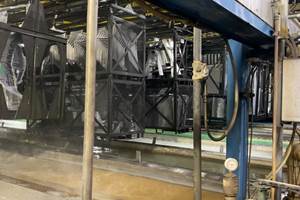Fast Track to Rugged Aqueous Cleaning
Tips to help you choose a system for profit, performance and quality.
A great parts-cleaning program is a value-added activity that gives your company a competitive advantage. Strategize a well-designed, lean cleaning process and you’ll get big paybacks in product quality, improved throughput and higher profits.
Clean Critically
Clean because you need to, not because Mom told you to (unless Mom owns your company and threatens to fire you if you refuse). This may seem like strange advice from someone known as “the cleaning lady,” but to achieve effective, lean, critical cleaning you must first understand why you are cleaning. Determine at what production stages and to what degree you have to clean the product. This is not a trivial exercise. Ask yourself: What metals am I cleaning? What other materials are present? What soils are being removed? What are the next steps in the process?
Define your critical cleaning processes. This means review all manufacturing processes and figure out which ones are serving to clean the part; you may be ignoring an important cleaning process because someone has given it another name or because it also has another function.
We prefer the term “critical cleaning” over “precision cleaning” or “industrial cleaning.” You can buy expensive, automated cleaning equipment to do “precision cleaning,” but it may not be an effective process for your product line. The critical cleaning step might be what most of us would call industrial cleaning. For example, many of our clients find that a simple dip tank to remove soils immediately after machining prevents dirt from baking on and allows for easier cleaning at later stages. In other cases, in well-established processes, we find that some cleaning steps can be eliminated to free up budgetary resources for really important processes. This is one reason why we called our book The Handbook for Critical Cleaning. The critical cleaning step may happen in the machine shop.
New Soils — New Process?
Soil is matter out of place. Cleaning removes soils from the surface without damaging the product. The definition of matter out of place depends on the situation. Metalworking fluids and polishing compounds that are crucial to fabrication may become soils at later stages because they interfere with product appearance, surface attributes or function.
Metalworking fluids, including lubricants and rust preventatives, are being reformulated with higher boiling materials, primarily in response to environmental requirements. Higher boiling lubes tend to leave more residue. Biobased lubricants are also being promoted as a domestic, renewable resource. However, biobased products can change in composition during use and storage, resulting in a varnish-like material. If you or someone in the supply chain starts using different soils, you may have to change the cleaning process to avoid an increase in the defect rate.
Your Supply Chain
If you do final assembly, make sure your sub-vendors provide you with clean parts. You specify the dimensions; perhaps you specify the coating. Make sure you are getting a consistent manufacturing process—this includes the cleaning process. We see too many problems with parts where the surface coatings and assorted surface treatments and finishes do not hold up through the assembly process or where there is batch-to-batch variation of parts. There may not be a problem with your manufacturing processes. Perhaps someone in your purchasing department, in a burst of enthusiasm, moved to a new parts supplier. It may be that your supplier did not clean the parts or changed the cleaning process or used a new lubricant without changing the cleaning process. Understand what you need; then specify the cleaning requirements and the paperwork.
If you supply parts to final assemblers, make sure you have a rugged cleaning process. Consider using the fact that you supply clean parts with stable, adherent coatings and finishes as part of your marketing campaign. Show your customers that your helicoils do not “weep” lubricant. Make their lives easier. This is all possible if you use common sense and “street smarts” in putting together your aqueous cleaning process.
Think, Plan and Save Money
Cleaning, particularly aqueous cleaning, is a process. Cleaning includes the cleaning chemistry, temperature, force (physical cleaning action) and time. This means you have to build the process.
Understand your own processes, including your supply chain. Know what is “street legal” in your geographic area in terms of safety and environmental requirements. Table 1 provides a few questions for the cleaning equipment vendor; customize the questions to fit your needs. Put together a similar table for suppliers of cleaning chemistry.
Chemistry
Aqueous cleaning agents are chemical blends. Most aqueous products contain both organic and inorganic chemicals. These chemicals have many functions. For example, some dissolve the soils, others react with fats to form soaps, still others prevent hard water from leaving residue on the product or act to inhibit corrosion. The appropriate chemical blend depends on the process.
Passivation is not the same as cleaning. Generally, high-pH or basic aqueous cleaning agents are needed to remove oils and other organics. More than occasionally, people tell us that passivation is their cleaning step. Acidic passivation can effectively burn on contaminants.
Equipment
Cleaning has three steps or stages: wash, rinse and dry. These three distinct steps have related but separate functions, and each stage often requires specialized equipment, particularly for aqueous processes.
Too often, one or more of these steps is either ignored or deferred; it is more cost-effective in the long run to plan the entire process at once. Determine whether or not you need rinsing and drying, and budget for all three steps.
Wash. The wash step (cleaning step) delivers the cleaning agent to the surface, provides cleaning action to remove soil without damaging the materials of construction or the surface properties, and physically removes the soil from the proximity of the surface.
Rinse. The rinse stage removes the cleaning agent and sometimes continues the cleaning process. For an in-line (conveyor belt) washer, the times of parts in the wash and rinse sections is important. With batch systems (individual tanks), some larger processes can be automated to allow a longer time in one or more of the steps.
A number of different rinse-tank configurations are possible, and the process can be programmed to manage products with different requirements. However, batch systems require lifting the part out of one tank and placing it in another. Automation is a boon to process control
If very hot water is used for washing or if flash drying is a potential problem, it is a good idea to have a spray system between the wash and rinse tanks. The spray system avoids the problem of having residual soil and/or cleaning agent dry onto the part; dried-on soils can be particularly difficult to remove. A reverse cascade, where the cleanest water is used in the last rinse and then flows upstream toward the initial rinse, is a good plan.
Water quality is also important in rinsing. Use of tap water can be problematic, and deionized water can scavenge metal from the part and cause corrosion or erosion. An appropriate rust inhibitor can be considered at the rinse stage. Remember that rust preventatives are additives that are meant to be a beneficial contamination on the surface, so it is important to choose one that is appropriate to your application.
Dry. The drying step removes water and sometimes other volatile materials from parts. An adequate drying system is important to avoid water spots, corrosion and part recontamination during the drying process itself.
In terms of time, drying is typically a bottleneck. Both drying and cool-down time have to be considered in the process flow. Despite the importance of drying, as the last step in the process, drying is the most overlooked, underfunded step. Be sure to allow adequate engineering time and budget to develop the drying step.
Melding Chemistry and Equipment
The cleaning chemistry and cleaning equipment have to be considered in parallel, not selected sequentially. For example, selecting a cleaning chemistry that is not right for use with high-pressure sprays can result in a shop full of bubbles. The appropriate chemical blend for your process also depends on the soil being removed and on the surface being cleaned.
Oil-splitting versus emulsion chemistries also have advantages and disadvantages. Generally, if a process bath will be reused many times, bath life will be enhanced by using an oil-splitting chemistry. This is just what it sounds like the oil rises to the top and can be skimmed off. However, if you do not skim the oil off, there is a good chance of recontamination as the product is lifted through the layer of oil. An overflow skimmer or weir prevents the problem; you must consider a weir in selecting equipment.
On the other hand, some very-small-scale critical processes call for a change of cleaning agent for each batch. If so, an oil-splitting chemistry might not be appropriate.
Essential Peripherals
Make sure that the cleaning equipment you are being sold has peripherals important to your process. Keeping the process bath in good shape saves time and money and contributes to a rugged process. Filters, weirs or skimmers are essential to maintaining the process bath. If you think you can do without filtration, consider the cost of disposing of the spent cleaning agent. Consider lost process time.
Consider also the steps before and after cleaning. If technicians have to re-fixture product before or after the cleaning step, you are losing time and money, and maybe compromising quality by inadvertently recontaminating the product. Successful cleaning requires integrating the cleaning process into the total manufacturing process, and integrating automation and fixturing for good process flow.
This could also mean using small-cell cleaning systems or one large central system. Locate the cleaning systems where you need them, and make sure the systems will fit into the available workspace, fit through the door and have vertical room for the hoists. Allow space for repair and preventive maintenance. If people cannot access the cleaning system, they will not maintain it. If they do not maintain it, quality and productivity will suffer.
Performance, Environment, Safety
One of the more difficult questions to ask the cleaning chemistry supplier is: What exactly is in this product? You may not get a complete answer, given competitive issues. However, if you get complete evasion, find another supplier. Safety and environmental considerations also include cleaning force and heat, not just the cleaning chemistry.
Avoid being shut down because your process is not “street legal.” Because nearly all aqueous cleaning agents contain organic and inorganic additives, it is important to determine any potential safety hazards and environmental constraints. Even if the cleaning agent is labeled biodegradable and even if it has no stated hazardous ingredients, the used cleaning agent may contain a variety of process materials and dissolved metals; it may have to be treated as a hazardous waste. Double-check claims of “no VOCs;” the manufacturer may have used a test method designed for coatings or lubes, not for cleaning agents. Be sure to do all the regulatory paperwork, and make sure your permits are in order.
Buy Quality
We are often asked the secret to finding bargain cleaning equipment and cleaning chemistries. The secret is: buy quality.
Buying quality does not necessarily mean purchasing the most expensive system or the one with the most bells and whistles. It does mean purchasing what is appropriate for your application. For cleaning chemistries, consider the dilution factor, bath life and performance. For equipment, consider reliability and energy requirements. Aqueous cleaning systems require heat; heat loss steals energy and profits. Purchasing efficient, insulated equipment is not tree-hugging, it is good business.
Quality also involves purchasing the right process for the application. A surprising number of manufacturers buy very costly cleaning systems out of a catalog, perhaps based on someone’s previous experience with the supplier. If you are contemplating spending a substantial amount of money, get competitive bids. Have the vendors walk through your facility. Ask for references, and check those references. Let me repeat this: ask for references, and follow-up on those references. Ask about the equipment, the application, the performance and ongoing product support.
Communicate
There is no substitute for communication and partnership when you put together a new industrial or critical cleaning process or any other process for that matter. At a recent panel discussion, manufacturers claimed that equipment and chemistry suppliers did not really grasp what was going on in the trenches. The vendors responded that the parts manufacturers did not tell them what they really needed. Sometimes, suppliers had to build to print or design in a mental vacuum.
Sure, we all have competition-sensitive issues, but tell suppliers what you need. Even more important, give them feedback. If you expect a new process to work on the first try, I have some underwater real estate to sell you. Let them know what does not work, and tell them what does work.
Related Content
Installing an Ecoat Line
Thinking of investing in electrocoating capabilities? George Lovell, coatings plant manager for Lippert, discusses considerations you should keep in mind as you add your ecoat line.
Read MoreHow to Maximize Nickel Plating Performance
The advantages of boric acid-free nickel plating include allowing manufacturers who utilize nickel plating to keep up the ever-changing regulatory policies and support sustainability efforts.
Read MoreHow to Address Declining Powder Coating Coverage Over Time
Fine particles from reclaim could be to blame for powder coating problems that emerge over time. Avoid problems by keeping hooks clean, maintaining guns and using reclaim powder quickly to avoid accumulation of fines.
Read MoreHow to Choose Between Sulfate and Chloride-Based Trivalent Chromium
There are several factors to consider when choosing between sulfate and chloride-based baths for trivalent chromium plating. Mark Schario of Columbia Chemical discusses the differences and what platers should keep in mind when evaluating options.
Read MoreRead Next
A ‘Clean’ Agenda Offers Unique Presentations in Chicago
The 2024 Parts Cleaning Conference, co-located with the International Manufacturing Technology Show, includes presentations by several speakers who are new to the conference and topics that have not been covered in past editions of this event.
Read MoreEducation Bringing Cleaning to Machining
Debuting new speakers and cleaning technology content during this half-day workshop co-located with IMTS 2024.
Read MoreDelivering Increased Benefits to Greenhouse Films
Baystar's Borstar technology is helping customers deliver better, more reliable production methods to greenhouse agriculture.
Read More


























